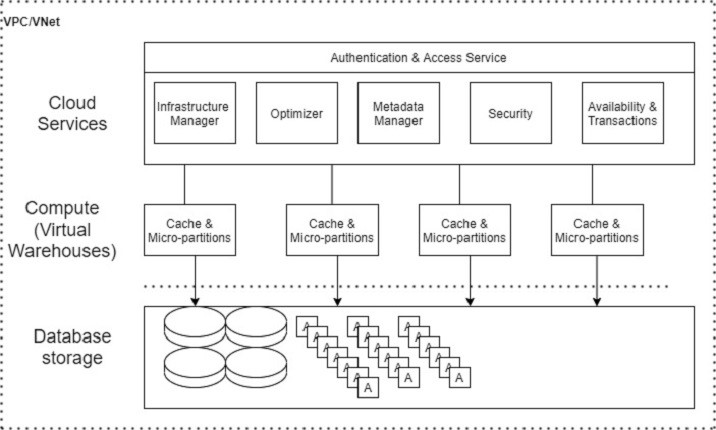Snowflake Revolutionizing Data Warehousing ,Analytics and self-managed service

Introduction
In the world of data management and analytics, Snowflake has emerged as a revolutionary platform that is changing the way organizations handle and analyse their data. Snowflake’s cloud-based data warehousing architecture has brought a new level of scalability, flexibility, and simplicity to the field of data management. Snowflake, known for its cloud-native data warehousing solutions, has recently introduced a self-managed service offering, expanding its capabilities to cater to a broader range of organizations and data management needs. This innovative approach allows organizations to deploy and manage the Snowflake Data Platform on their terms, providing greater control, flexibility, and customization.
Key Features of Snowflake
1. Data Sharing: One of Snowflake’s standout features is its ability to easily share data between organizations and departments, all while maintaining strict control over access and security. This makes it an ideal choice for collaborative data projects and data monetization.
2. Separation of Storage and Compute: Snowflake’s architecture separates storage from computing, allowing organizations to scale their resources independently. This means you can allocate more or less compute power as needed without disrupting data storage.
3. Multi-Cloud Support: Snowflake is available on multiple cloud platforms, including AWS, Azure, and Google Cloud. This multi-cloud support gives users the flexibility to choose the cloud provider that best suits their needs.
4. Data Security: Snowflake prioritizes data security with features like automatic encryption, data masking, and role-based access control. It complies with various industry standards and regulations, making it a trusted choice for sensitive data.
Snowflake as a Self-Managed Service
1. Deployment Flexibility: Snowflake as a self-managed service allows organizations to deploy the platform on their preferred cloud infrastructure or even on-premises, providing complete control over the environment.
2. Customization: Organizations can tailor the configuration of Snowflake to meet specific performance, security, and compliance requirements. This flexibility is particularly valuable for industries with stringent data regulations.
3. Infrastructure Control: Self-management empowers organizations to have direct control over the underlying infrastructure, including compute resources, storage, and networking, enabling fine-tuned optimizations.
4. Hybrid Deployments: Snowflake’s self-managed service facilitates hybrid deployments, where data can be stored on multiple clouds or on-premises while still taking advantage of Snowflake’s powerful query processing capabilities.
5. Security and Compliance: Organizations can implement their own security measures and compliance protocols, ensuring data governance aligns with internal policies and industry regulations.
6. Cost Management: Self-managed Snowflake allows for cost predictability and optimization, as organizations have granular control over resource allocation and can adjust as needed.
Snowflake’s architecture is built around a few key components:

1. Virtual Warehouses: These are compute resources that process SQL queries and perform data transformations. Users can scale virtual warehouses up or down depending on their query workload.
2. Storage: Snowflake stores data in a highly efficient, columnar format, which allows for fast query performance and minimizes storage costs.
3. Metadata: Metadata services manage the organization and accessibility of data. This includes information on tables, schemas, and data lineage.
4. Query Processing Engine: Snowflake’s query engine optimized SQL queries for maximum performance, making complex analytics queries run efficiently.
Impact on the Data Industry
Snowflake has had a profound impact on the data industry, revolutionizing the way organizations handle their data:
1. Scalability: Snowflake’s elastic scaling capabilities have eliminated the need for extensive capacity planning. Organizations can scale resources up or down on-demand, which is particularly valuable for handling fluctuating workloads.
2. Simplified Management: With Snowflake’s cloud-native approach, organizations no longer need to worry about hardware provisioning, software updates, or maintenance. This simplifies data management and allows teams to focus on analytics.
3. Cost Savings: Snowflake’s pay-as-you-go pricing model ensures that organizations only pay for the resources they use, resulting in significant cost savings compared to traditional on-premises data warehousing solutions.
4. Accessibility: The cloud-based nature of Snowflake makes data more accessible to a wider range of users within an organization, enabling better decision-making and collaboration.
5. Enhanced Control: Organizations that require maximum control over their data infrastructure can now deploy and manage Snowflake according to their unique needs, ensuring data sovereignty and adherence to specific compliance requirements.
6. Versatility: Self-management extends Snowflake’s reach to organizations with diverse data ecosystems, including those that may not be fully cloud-native or have complex hybrid infrastructure setups.
7. Data Resilience: Self-management enables organizations to implement disaster recovery and high availability solutions tailored to their business continuity needs.
Its cloud-based architecture, scalability, and ease of use have made it a preferred choice for organizations looking to manage and analyse data efficiently. As data continues to play a critical role in modern business, Snowflake’s innovative approach to data management is poised to shape the future of the industry, enabling organizations to extract valuable insights and make data-driven decisions with greater ease and agility.